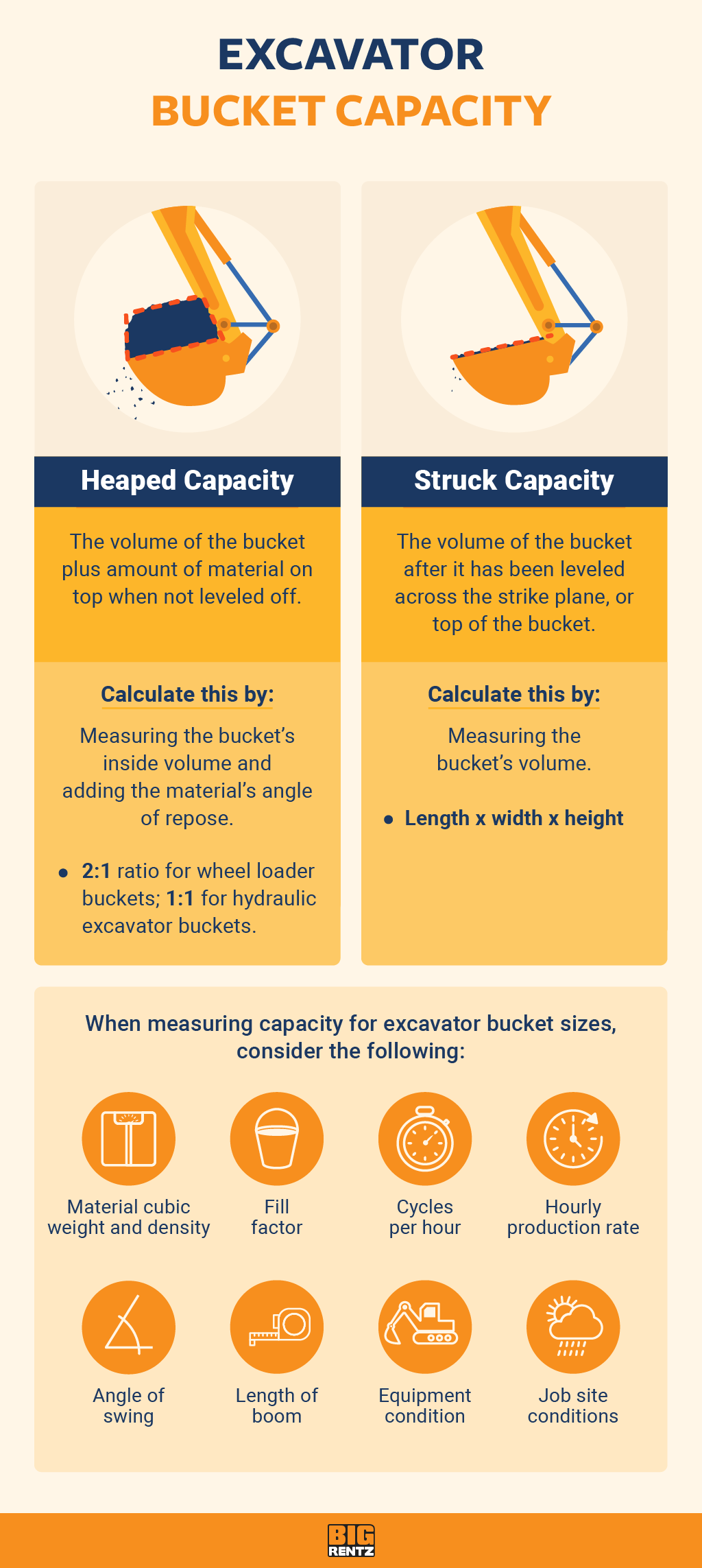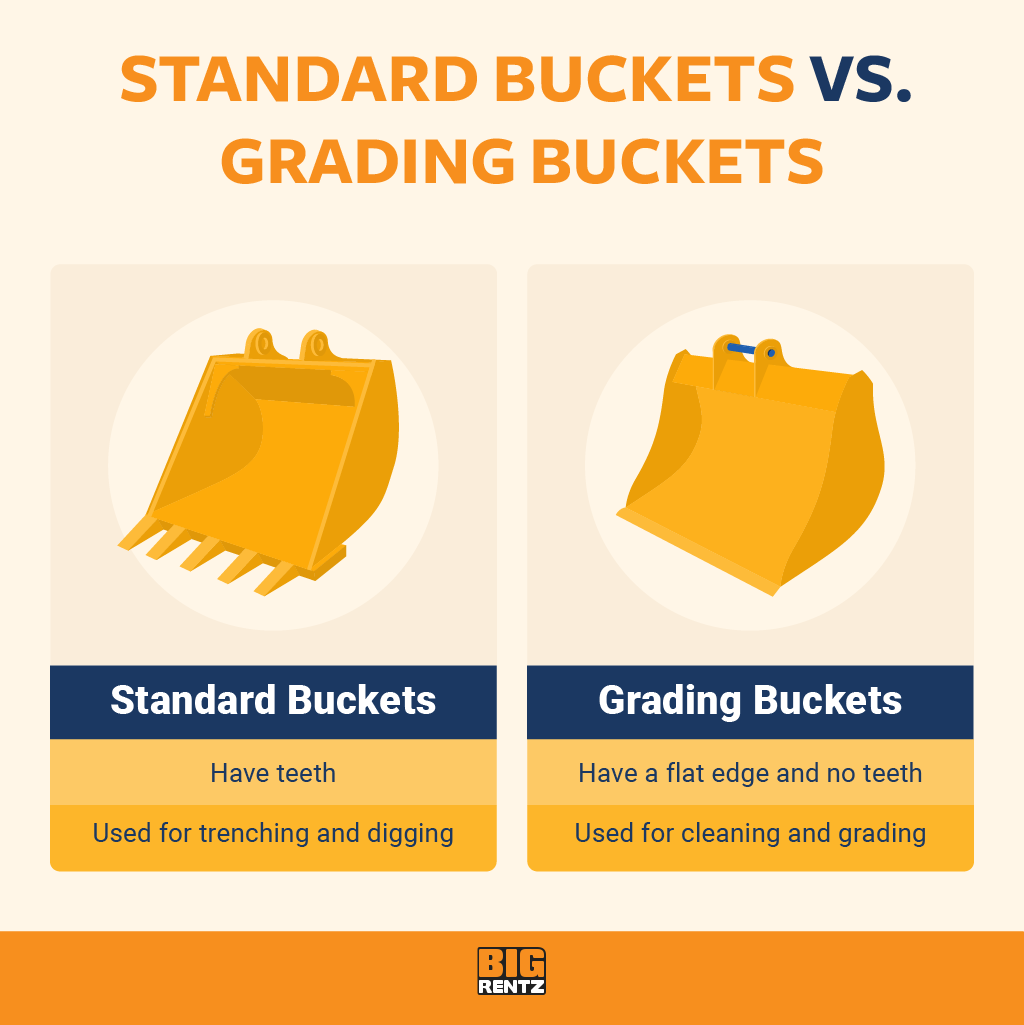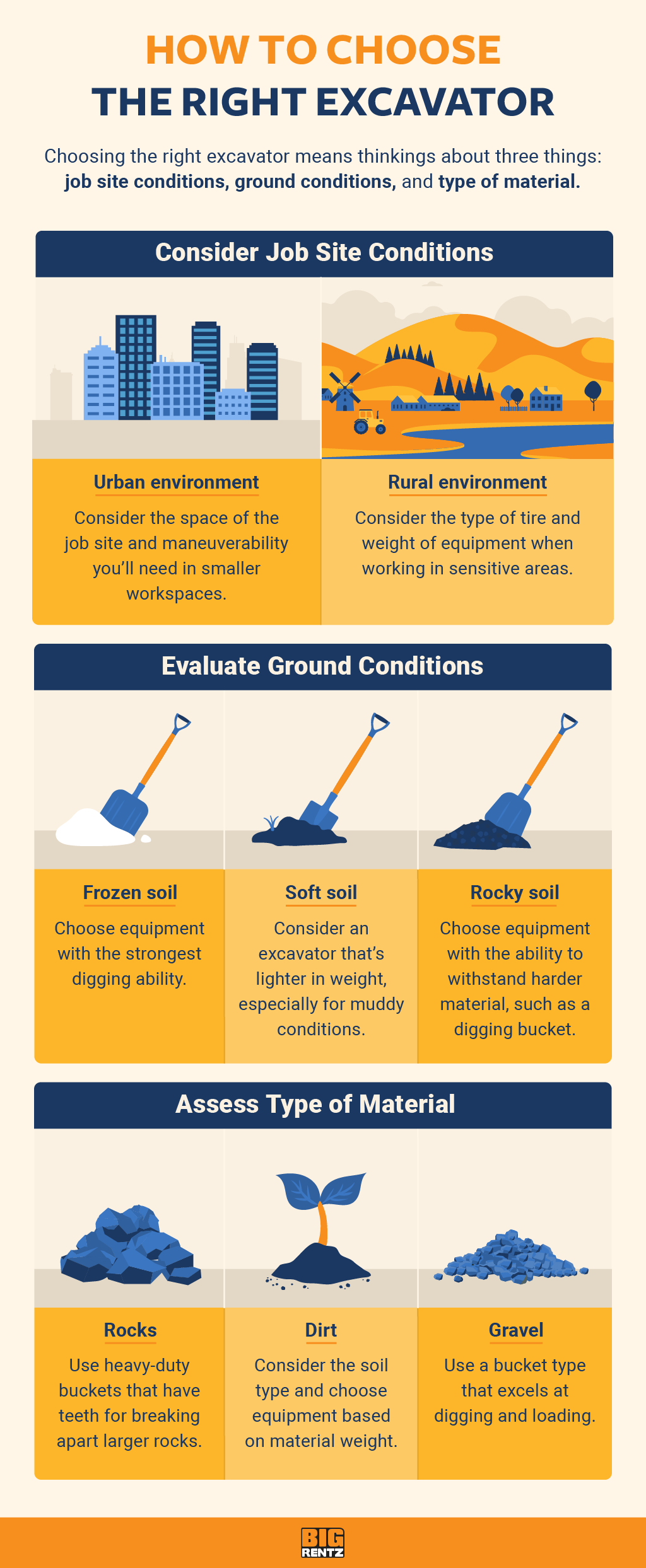Keywords: excavator ditching bucket, grading bucket, backhoe rock bucket
excavator ditching bucket
grading bucket
backhoe rock bucket
If your next construction job requires an excavator, it’s important to be mindful of excavator bucket sizes and types. Our excavator bucket size chart can help you choose the right equipment. The table below shows the approximate bucket sizes that excavators can accommodate. However, make sure to check your model’s specifications.
Explore All Excavators
Excavator Bucket Size Chart
When it comes to excavator bucket sizes, it is important to match the bucket to the appropriate type of excavator and its intended uses. Buckets are typically measured by their inside width. The larger the excavator, the larger the bucket it can handle, and the bigger the load it can move.
| Excavator Weight (tons) | Standard Bucket Width (inches) | Grading Bucket Width (inches) |
| >0.75 | 6-24 | 30 |
| 1-1.9 | 6-24 | 36-39 |
| 2-3.5 | 9-30 | 48 |
| 5-6 | 12-36 | 60 |
| 7-8 | 12-36 | 60-72 |
| 10-15 | 18-48 | 72 |
| 19-25 | 18-60 | 84 |
How To Calculate Excavator Bucket Capacity
The bucket capacity of an excavator will vary based on many factors including material density, fill factor, and production rate. The bucket that worked for crushed stone may not work for loose soil.

When calculating excavator bucket capacity, follow these steps:
- Determine the standard weight of whatever material you will need to lift, using a reputable source. Each bucket will come with a fill factor sheet that lists various materials. These values will tell you how much of a certain material the bucket can handle based on material density.
- Next, time the digging operation of the excavator. Start when the bucket begins to dig in, and stop when it starts to dig on the next load. Divide that number by 60 to find the cycle time for the excavator.
- Use the cycle time to determine an hourly production rate. Divide the hourly goal weight of loaded material by the cycle time. For example, if you must move 500 tons per hour, and the cycle rate is 120 cycles per hour, you must move 500/120 = 4.17 tons per cycle.
- Divide the cycle payload amount by the material density discovered in the first step. This will provide you with the bucket’s nominal capacity.
- Finally, divide the nominal capacity by the material’s fill factor to get the needed capacity of each bucket for whatever material you need.
Brands will typically provide a chart that shows the bucket capacity based on bucket size and material.
How To Calculate Lift Ratio
Once you’ve determined the capacity your bucket needs, you have to be sure the excavator can safely lift it. This is determined by the machine’s lift ratio, which is essential to ensure safe and efficient machine operation.
- First, obtain the maximum lift capacity of the excavator. This should be listed with the machine spec data or obtained from the original equipment manufacturer.
- Next, add the maximum lift capacity to the weight of the bucket listed by the OEM. This combined value is called the adjusted lift capacity.
- Add the weight of any additional arm attachments, such as quick couplers and thumbs.
- Use standard charts to find the density of the material you need to move.
- Multiply the bucket capacity by the material density to find the potential max fill weight of the bucket. Then, add that to the total attachment weight to determine the total lift weight.
- Finally, divide the lift weight by the adjusted lift ratio to find the lift ratio. If the ratio is less than 1.0, it is suitable for the job. If it is larger than 1.0, the bucket is too big for the specified job.
In other words, a ratio above 1.0 indicates that the machine is lifting loads larger than it should be. Either a larger excavator is necessary or a smaller bucket is needed to ensure safe operation.
Types of Excavator Buckets
There are several types of excavator buckets. Grading buckets are more shallow than standard buckets, allowing for confined work like ditch cleaning. Meanwhile, trenching buckets are narrow and designed to make quick work of trenching operations.
Ensuring you have the right one for the job will help you make the most of your time, productivity, and budget.
Standard Buckets
Standard buckets, also known as general purpose buckets, are versatile. They’re commonly used for digging or loading materials like topsoil or loam.
They are usually the lightest of all bucket types due to the lack of any reinforcement to the bucket itself. Therefore, standard buckets can typically lift higher volumes of material in each cycle because they are lighter and the excavator is not expending as much energy on them.
Standard buckets are commonly used for:
- Excavation of dirt, topsoil, silt, loam, and more.
- Backfilling soil.
- Loading piles of fine gravel into trucks.

Grading Buckets
Grading buckets, or ditching buckets, are designed for cleaning ditches as well as sloping and grading for finishing jobs. Grading buckets are usually more shallow and compact than other buckets to allow for tight and sloped conditions. They may also have drainage holes.
Grading buckets are commonly used for:
- Cleaning ditches of debris.
- Grading sloped areas.
- Moving material that is mixed with liquid.
Heavy Duty Buckets
Heavy duty buckets are designed for the toughest jobs. They come in three categories: heavy duty, severe duty, and extreme duty. Extreme duty buckets feature the heaviest reinforcement armor along with specialized abrasion-resistant tips and materials for greater breakout force. They also use side cutters on the outside of the bucket to help break through dense material.
Heavy duty buckets are commonly used for:
- Breaking through highly dense materials.
- Moving highly abrasive materials.
- Repeated and deep digging in rocky areas.
Trenching Buckets
Trenching buckets are narrow and designed for trenching applications. They can be used for general soil digging and movement, but their straight cutting edge and long floor design are ideal for digging deep trenches in narrow areas.
Trenching buckets are commonly used for:
- Digging trenches for utility work.
- General excavation and backfilling in standard-duty soil types.
- High-precision projects, such as digging between pipes.
Tilt Buckets
Tilt buckets are a type of grading bucket. Featuring specialized hydraulic components, they can tilt 45 degrees right and left. This allows for more specific applications and helps them cover a larger work area without frequent repositioning.
Tilt buckets are commonly used for:
- Precision slope grading.
- Cleaning oddly shaped ditches and trenches.
- Specialized landscaping needs.
Specialty Buckets
There are also several bucket styles designed for specialized needs. From sifting operations to buckets intended to break through the toughest materials, there’s a bucket for every job.
- Riddle buckets: Riddle buckets are like standard buckets with holes or slots in the back. They are used to process and separate aggregate at a job site, such as sifting stones from the soil.
- V-buckets: V-buckets are trenching buckets that create a V-shaped trench instead of a flat-bottom channel.
- Rock buckets: Rock buckets have sharp teeth and extra reinforcement to break through rocky environments. They may also feature side wear plates and high-strength rippers to dig into rocky surfaces.
- Hard-pan buckets: Like rock buckets, hard-pan buckets are reinforced to break through tough soil and thick rock while ensuring durability. They also have an extra row of teeth to further break up material during digging.
- Cemetery buckets: As the name suggests, cemetery buckets are designed to dig a cemetery plot with straight walls and a flat bottom.
How To Choose the Right Excavator Bucket for Your Job Site
Choosing the right excavator bucket depends on many factors. Different job sites will have different ground conditions that can demand specialized buckets. Other factors, including climate, location, and surrounding hazards, must be assessed. It is essential to factor in all variables before renting an excavator and any accessories.

Job Site Conditions
First, consider the condition of the job site. Is it development in the cold mountains, digging through dense rock and frozen ground? Or perhaps a residential area that can only fit a mini excavator?
Ground Conditions
Likewise, you must know the type of ground you will be digging into. High-sand soils are much more abrasive. Unstable soil can also force you to use a smaller, lighter excavator, limiting the maximum bucket size available to you.
Material Weight and Type
What will you be digging through? Heavier materials will require heavy-duty buckets with reinforcements and specialized bucket teeth. Lighter materials may allow for a larger bucket size that lets you get the job done more quickly.
Do You Need Excavator Attachments?
Excavators can fit many specialized excavator bucket attachments designed for specific job uses. For example, hammers can help break up hard earth or asphalt and thumbs can hold debris in the bucket or clamp down on different materials.
If your excavator bucket provides all the capabilities you need, you may want to consider excavator attachments to help.
Conclusion
Excavators are rugged machines known for their versatility on the job site. They can handle tough digging conditions, clean-up jobs, and nearly everything in between. Knowing what kind of bucket to use for each job is just as important as the excavator itself.
Look for the bucket that fits all of your job site needs. Remember to consider material composition, climate, and even maneuverability needs.
If you need to rent an excavator or any type of heavy equipment for your next job, BigRentz is your heavy equipment rental expert.
Explore All Excavators